Daisy’s Ricefish Care Guide: Keep Your Nano Tank Sparkling
Among the most underrated treasures of nano aquariums, Daisy’s Ricefish shimmer with elegance and grace. These tiny iridescent fish captivate aquarists with their pastel hues and peaceful personalities. Despite their delicate appearance, they are surprisingly hardy and easy to care for—making them ideal for both beginners and seasoned hobbyists. Whether you’re looking to add a touch of tranquility to your aquascape or seeking a schooling species that won’t outgrow a small tank, Daisy’s Ricefish may be your perfect match. In this guide, we’ll explore everything you need to know to keep them healthy, vibrant, and thriving in your care.
- Quick Care Stats
- Species Overview
- Appearance
- Tank Requirements
- Tank Setup
- Diet and Feeding
- Tank Mates
- Breeding
- Diseases & Treatment
- Conservation and Ethical Considerations
- Frequently Asked Questions (FAQs)
Quick Care Stats
- Scientific Name: Oryzias woworae
- Common Name: Daisy’s Ricefish, Daisy’s Blue Ricefish
- Origin: Southeast Sulawesi, Indonesia (Muna Island)
- Max Length: 1.2 inches (3 cm)
- Minimum Tank: 10 gallons (38 liters)
- Stocking: 6–10 fish per 10 gallons; compatible with peaceful tankmates
- Temperament: Peaceful, schooling
- Feeding: Omnivorous; small flakes, micro-pellets, live/frozen foods
- Breeding: Egg-layer; easy to breed with proper setup
- Habitat: Slow-moving streams, ponds with dense vegetation
- Tank Setup: Heavily planted, low flow, dark substrate
- Active Tank Levels: Middle to top
- Temperature: 73–81°F (23–27°C)
- pH: 6.0–7.5
- Water Hardness: 5–15 dGH
- Lifespan: 3–4 years
Species Overview
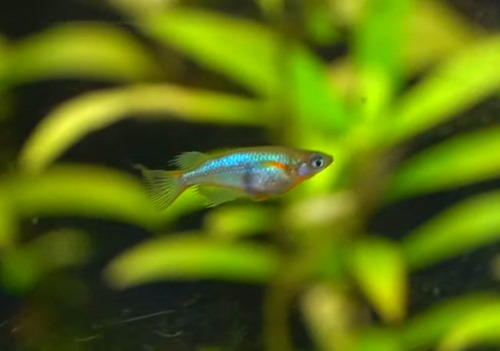
Endemic to Mata air Fotuno, a clear, slow-moving stream on Muna Island in Southeast Sulawesi, Indonesia, Daisy’s Ricefish inhabit waters rich with aquatic plants and biofilm. Discovered in 2007, they were named to honor Daisy Wowor’s contributions to carcinology. These small, vibrant fish thrive in shallow, vegetated habitats where they feed primarily on biofilm and small invertebrates, utilizing the dense plant cover for protection from predators. Their delicate, translucent bodies, often adorned with subtle iridescent hues, make them a striking presence in their niche ecosystem.
The ricefish’s habitat in Mata air Fotuno is characterized by stable water conditions, with temperatures ranging from 24 to 28°C and a neutral to slightly alkaline pH. The stream’s slow current and abundant aquatic vegetation provide an ideal environment for their survival, fostering a microecosystem rich in microorganisms that form the basis of their diet. Daisy’s Ricefish are known for their adaptability to these specific conditions, but their restricted range makes them vulnerable to environmental changes, such as habitat degradation or water pollution, which could disrupt their delicate ecological balance.
Conservation efforts for Daisy’s Ricefish are limited but critical due to their endemic nature. Local initiatives aim to protect Mata air Fotuno from agricultural runoff and deforestation, which threaten the stream’s pristine conditions. Research on their breeding habits and ecological role continues, with hopes of establishing captive breeding programs to safeguard the species. Their discovery highlights the importance of preserving small, unique habitats, as even minor disruptions could lead to the loss of this remarkable species and the biodiversity of Muna Island.
Appearance
Daisy’s Ricefish are celebrated for their iridescent, jewel-like coloration, which makes them a standout in nano setups. Key features include:
Base Color: Males shimmer with a metallic blue body that reflects light brilliantly, creating a sparkling effect under proper lighting. Females display a warm yellow-gold hue with subtle orange accents along their sides, giving a softer but still striking appearance.
Fins: Males boast elongated dorsal and anal fins with vivid red or crimson edges, adding flair to their movements. Females have shorter, translucent fins with minimal coloration, maintaining a more subdued profile.
Body Shape: Their slender, elongated bodies feature a slightly upturned mouth, adapted for surface feeding on small organisms like zooplankton and biofilm in their native habitat.
Sexual Dimorphism: Males are slimmer, with more vibrant blue coloration and extended, colorful fins. Females are plumper, with muted yellow-gold tones and faint orange accents along the lower body, making sexing relatively straightforward.
Size: Growing to 1.2 inches (3 cm), males are slightly smaller and more streamlined, enhancing their delicate, agile appearance in planted tanks.
Additional Notes on Appearance
The intensity of their colors is influenced by diet, water quality, and stress levels. A nutrient-rich diet and stable tank conditions enhance the males’ metallic blue sheen and females’ golden hues, while stress or poor water quality can dull their vibrancy. A dark substrate and subdued lighting amplify their iridescence, making them a focal point in well-designed aquariums.
Tank Requirements
A 10-gallon tank is suitable for a school of 6–10 Daisy’s Ricefish, though a 15–20-gallon tank is preferred for community setups to accommodate tankmates and reduce competition. Stock conservatively at 1 fish per 1–2 gallons, factoring in the bioload of other inhabitants. Maintain water parameters mimicking their natural stream environment:
- Temperature: 73–81°F (23–27°C)
- pH: 6.8–7.5
- Hardness: 7–15 dGH
- Ammonia/Nitrite: 0 ppm
- Nitrate: <20 ppm
Their tendency to jump, especially when startled or during feeding, necessitates a secure, tight-fitting lid with no gaps. Daisy’s Ricefish are sensitive to ammonia and nitrites, so a fully cycled tank with a reliable filtration system is critical. Weekly water testing with a high-quality test kit and 20–30% water changes maintain pristine conditions, ensuring their health and longevity.
Tank Setup
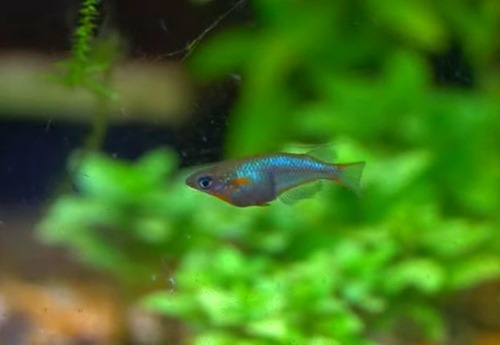
To replicate their native Mata air Fotuno habitat, create a heavily planted tank that fosters biofilm growth and provides security. Use fine-leaved plants like Java moss, Java fern, Anubias nana, or cabomba, paired with floating plants such as water lettuce or Salvinia to offer shade and mimic their preference for vegetated waters. These plants not only provide cover but also support biofilm, a natural food source. A dark sand or fine gravel substrate enhances their iridescent blue and red colors, creating a striking visual contrast. Incorporate driftwood, smooth river rocks, or Indian almond leaves for authenticity and to release beneficial tannins that soften water and reduce stress.
Use a gentle filtration system, such as a sponge filter or low-flow hang-on-back filter, to maintain slow currents, as strong water movement can stress these small fish. A reliable aquarium heater ensures stable temperatures, as fluctuations can lead to health issues. Dimmable, low-intensity LED lighting suits their preference for subdued light, preventing stress while highlighting their colors. Ensure the tank is fully cycled before introducing ricefish to avoid ammonia or nitrite spikes.
Diet and Feeding
Daisy’s Ricefish are omnivorous, with a natural diet of zooplankton, small insects, and biofilm in their native stream. In captivity, they thrive on a varied diet tailored to their tiny mouths. Recommended foods include:
- Dry Foods: High-quality flake foods or micro-pellets formulated for small tropical fish serve as a staple. Choose products with a balance of protein and plant matter to meet their omnivorous needs.
- Live/Frozen Foods: Offer protein-rich treats like freeze-dried or frozen brine shrimp, daphnia, or bloodworms to promote vibrant colors and active behavior. Live foods stimulate natural foraging instincts.
- Vegetable Matter: Include plant-based options such as spirulina flakes, algae wafers, or blanched greens (e.g., spinach, zucchini) to mimic their biofilm grazing. These provide essential fiber and nutrients.
- Feeding Frequency: Feed 1–2 times daily in small amounts that they can consume in 2–3 minutes to prevent overfeeding and water fouling. Split feedings (morning and evening) ensure consistent nutrition.
Feeding Tips
- Vary the diet weekly to prevent nutritional deficiencies and enhance their iridescent colors. A mix of dry, live, and plant-based foods is ideal.
- Distribute food near the surface, as their upturned mouths are adapted for surface feeding. Ensure shy individuals eat by scattering food across the tank.
- Remove uneaten food promptly to maintain water quality, especially in nano tanks where waste accumulates quickly.
A diverse diet supports their health, strengthens immunity, and maximizes their shimmering blue and red hues.
Tank Mates
Behavior and Temperament
Daisy’s Ricefish are peaceful and active, thriving in groups of 6 or more where they exhibit loose schooling and playful chases. Their non-aggressive nature makes them ideal for community tanks, but their small size and surface-feeding habits make them vulnerable to competition from faster or bolder tankmates. Males may display mild fin-flaring during spawning, but this rarely leads to injuries. Their lively, darting behavior adds dynamism to planted tanks, but they may become shy or reclusive if stressed or housed with aggressive species.
Suitable Tankmates
Choose small, peaceful species that share similar water requirements and do not outcompete Daisy’s Ricefish for food. Ideal tankmates include:
- Fish: Small species like neon tetras, ember tetras, celestial pearl danios, Pygmy corydoras, or Kuhli loaches. These occupy different tank levels, reducing competition, and their peaceful nature complements the ricefish’s demeanor.
- Invertebrates: Dwarf shrimp, such as cherry shrimp or Amano shrimp, are compatible, especially if introduced first with dense plant cover to protect juvenile shrimp from occasional nipping. Snails like nerite or mystery snails are excellent, aiding in algae control without competing for resources.
- Avoid: Aggressive or fast-moving fish like bettas, tiger barbs, or cichlids, which may harass or prey on ricefish. Avoid larger species or those that dominate surface feeding, as they can outcompete the ricefish.
Tankmate Considerations
- Introduce shrimp before ricefish to allow them to establish territories and reduce predation risks on juvenile shrimp. Dense plants provide refuge for shrimp.
- Monitor interactions during introductions, as ricefish may be initially timid around new tankmates. Provide ample hiding spots to reduce stress.
- Ensure the tank is large enough (15+ gallons for community setups) to prevent overcrowding, which can increase competition and stress.
Breeding
Preparation for Breeding
Daisy’s Ricefish are prolific breeders in captivity when provided with proper conditions. Set up a dedicated 10-gallon breeding tank with fine-leaved plants like Java moss, cabomba, or spawning mops to serve as egg deposition sites. Maintain stable water parameters to encourage spawning:
- Temperature: 75–78°F (24–26°C)
- pH: 6.5–7.0
- Hardness: 5–10 dGH
- Water Quality: Ammonia and nitrite at 0 ppm, nitrates below 15 ppm.
Condition a group of 2–3 males and 3–4 females for 1–2 weeks with high-protein live foods like micro-worms, daphnia, or baby brine shrimp to boost fertility and health. Use a gentle sponge filter to maintain water quality without disturbing eggs or fry, and ensure a secure lid to prevent jumping. Dim lighting and dense plant cover reduce stress during spawning.
Breeding Process
Males court females with vibrant displays, flaring their red-edged fins and chasing them in short bursts. After mating, females carry 10–20 small, adhesive eggs near their ventral fin, depositing them one by one onto plants or spawning mops over several hours. Males fertilize the eggs during or shortly after deposition. Spawning occurs daily in small batches, making Daisy’s Ricefish continuous breeders under optimal conditions. The eggs are tiny, transparent, and sticky, adhering securely to surfaces. To prevent predation, either remove the adults to the main tank after spawning or carefully transfer the egg-laden plants/mops to a separate hatching tank with identical water parameters.
Caring for Fry
Eggs hatch in 9–15 days at 77°F (25°C), with warmer temperatures accelerating hatching to as little as 7 days. The fry are tiny and delicate, requiring specialized care:
- Initial Feeding: For the first 1–2 weeks, feed infusoria, paramecium, or commercial liquid/powdered fry food designed for small egg-layers. After 10–14 days, transition to newly hatched baby brine shrimp or micro-worms as they grow.
- Nursery Tank: Use a 5–10-gallon bare-bottom tank with gentle aeration and fine-leaved plants or spawning mops for cover. Maintain identical water parameters to the breeding tank, performing 10% daily water changes with aged, temperature-matched water to ensure pristine conditions.
- Growth and Development: Fry grow slowly, reaching about 0.5 inches (1.2 cm) in 6–8 weeks. Gradually introduce finely crushed micro-pellets alongside live foods. Monitor for cannibalism and separate larger fry if necessary.
Fry are highly sensitive to pollutants, so meticulous water quality management is essential for high survival rates.
Diseases & Treatment
Daisy’s Ricefish are hardy but susceptible to diseases if water quality deteriorates or stress occurs. Common health issues and treatments include:
Ich (White Spot Disease): Characterized by white spots on the body or fins, scratching, and lethargy. Treat by gradually raising the tank temperature to 78–80°F (26–27°C) for 3–5 days and adding aquarium salt (1 teaspoon per gallon, pre-dissolved) or a commercial ich medication (e.g., API Super Ick Cure), following instructions. Increase aeration during treatment and perform 20% water changes before and after to maintain water quality.
Fungal Infections: Cotton-like growths on the body or fins indicate fungal issues, often linked to poor water quality or injury. Treat with antifungal medications like methylene blue or API Pimafix, following dosage instructions. Improve water quality with 20–25% water changes and ensure ammonia/nitrite levels are 0 ppm.
Fin Rot: Tattered or discolored fins suggest bacterial infection, typically caused by poor water quality or stress. Treat with broad-spectrum antibiotics like API Furan-2 or Seachem Kanaplex, following instructions. Perform 20–25% water changes and address root causes like overcrowding or inadequate filtration.
Stress: Symptoms include faded colors, lethargy, or hiding, often triggered by poor water quality, aggressive tankmates, or sudden parameter changes. Test and stabilize water parameters, reduce disturbances (e.g., loud noises, bright lights), and ensure ample plant cover for security. Adjust tankmates if necessary.
Prevention
Prevent health issues with proactive care:
- Perform weekly 20–30% water changes using dechlorinated, temperature-matched water to maintain pristine conditions.
- Test water parameters regularly with a reliable test kit to ensure stability, particularly ammonia, nitrite, and nitrate levels.
- Clean filters monthly to maintain efficient filtration without disrupting beneficial bacteria.
- Quarantine new fish, plants, or invertebrates for 2–4 weeks to prevent introducing pathogens.
- Avoid overcrowding and monitor group dynamics to minimize stress and competition.
Daily observation of behavior and appearance allows early detection and treatment of issues, ensuring vibrant, healthy ricefish.
Conservation and Ethical Considerations
Daisy’s Ricefish are endemic to a single stream on Muna Island, making their wild populations vulnerable to habitat degradation from deforestation, agricultural runoff, and pollution. Aquarists should prioritize captive-bred specimens from reputable suppliers to reduce pressure on wild stocks and support sustainable aquaculture. Avoid purchasing from sources that may exploit wild populations, and verify that suppliers adhere to ethical breeding practices.
Never release Daisy’s Ricefish into non-native waters, as they could become invasive and disrupt local ecosystems. Supporting conservation initiatives, such as habitat restoration projects in Southeast Sulawesi or organizations like the Coral Triangle Initiative, helps protect their natural environment. Responsible aquarium practices—maintaining stable conditions, avoiding overstocking, and sourcing ethically—ensure these fish thrive in captivity without harming their wild counterparts.
Frequently Asked Questions (FAQs)
Q: Can Daisy’s Ricefish live with shrimp?
A: Yes, they coexist well with cherry or Amano shrimp in tanks with dense plant cover to protect juvenile shrimp. Introduce shrimp first to establish territories and minimize occasional nipping by ricefish.
Q: Do they need a heater?
A: A heater is essential to maintain 73–81°F (23–27°C), especially in cooler climates or during seasonal changes, as temperature swings can stress or weaken the fish.
Q: Are Daisy’s Ricefish good for beginners?
A: Yes, their hardiness and simple care needs make them beginner-friendly, provided aquarists maintain stable water conditions, perform regular maintenance, and monitor water quality diligently.
Q: How many Daisy’s Ricefish should I keep?
A: A school of 6–10 promotes natural schooling behavior, reduces stress, and enhances their vibrant displays, making the tank more visually appealing.
Q: Can they live in unheated tanks?
A: In tropical climates with stable room temperatures (75–80°F), a heater may not be needed, but in cooler regions, a heater is critical to prevent chilling, which can lead to illness.
Q: How do I enhance their colors?
A: A varied diet with high-quality flakes, live foods, and plant matter, combined with a dark substrate and proper lighting, maximizes their iridescent blue and red hues.
Q: How often do Daisy’s Ricefish breed?
A: In optimal conditions with stable parameters and abundant live food, they can spawn daily in small batches, producing 10–20 eggs per session, making them prolific breeders.

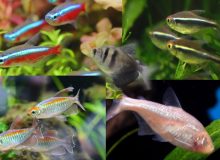
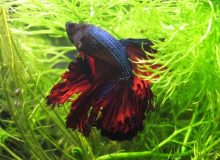
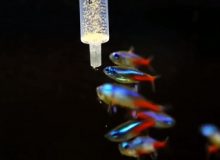
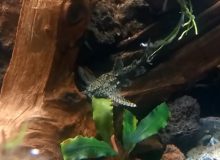
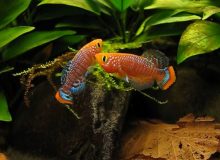
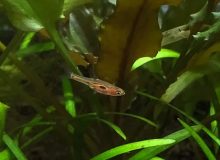
Leave a Reply